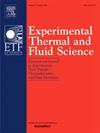Development of thin loop heat pipe for compact electronics
IF 2.8
2区 工程技术
Q2 ENGINEERING, MECHANICAL
Experimental Thermal and Fluid Science
Pub Date : 2025-05-03
DOI:10.1016/j.expthermflusci.2025.111510
引用次数: 0
Abstract
This study experimentally evaluates the thermal performance of a thin diffusion-bonded loop heat pipe (LHP) designed for electronics cooling applications. The device represents the third generation of an LHP with the same top-view dimensions of 76 x 60 mm2 and an identical wick structure. However, the thickness has been progressively reduced from 1.6 mm to 1.1 mm, and now to 0.8 mm. Despite this reduction, the LHP demonstrates good thermal performance. An advanced testing workbench, simulating actual electronic operating conditions, enables performance evaluation in horizontal, gravity-assisted, and against-gravity orientations. The evaporator and part of the condenser incorporate a sintered copper powder wick structure. While the lowest thermal resistance of 2.16 °C/W is observed in the gravity-assisted orientation, the LHP operates nearly independent of gravitational effects, exhibiting comparable thermal resistances in all orientations. The reduction in internal channel thickness led to an average decrease of 50 % in thermal performance compared to previous generations with thicker channels (1 mm and 0.5 mm). Nonetheless, the current LHP remains highly suitable for electronic applications due to its thin profile, efficiency, and ability to dissipate up to 8 W/cm2 without exceeding the maximum operating temperature of 100 °C.
小型电子设备用细回路热管的研制
本研究实验评估了为电子冷却应用而设计的薄扩散键合环路热管(LHP)的热性能。该装置代表了第三代LHP,具有相同的俯视图尺寸76 x 60 mm2和相同的灯芯结构。然而,厚度已经从1.6毫米逐渐减少到1.1毫米,现在到0.8毫米。尽管这种降低,LHP表现出良好的热性能。先进的测试平台,模拟实际电子操作条件,能够在水平,重力辅助和反重力方向进行性能评估。蒸发器和冷凝器的一部分包括烧结铜粉芯结构。虽然在重力辅助取向中观察到最低的热阻为2.16°C/W,但LHP的运行几乎不受重力影响,在所有取向中都表现出相当的热阻。与前几代更厚的通道(1毫米和0.5毫米)相比,内部通道厚度的减少导致热性能平均下降50%。尽管如此,目前的LHP仍然非常适合电子应用,因为它的外形薄,效率高,耗散高达8w /cm2的能力,而不超过100°C的最高工作温度。
本文章由计算机程序翻译,如有差异,请以英文原文为准。
求助全文
约1分钟内获得全文
求助全文
来源期刊

Experimental Thermal and Fluid Science
工程技术-工程:机械
CiteScore
6.70
自引率
3.10%
发文量
159
审稿时长
34 days
期刊介绍:
Experimental Thermal and Fluid Science provides a forum for research emphasizing experimental work that enhances fundamental understanding of heat transfer, thermodynamics, and fluid mechanics. In addition to the principal areas of research, the journal covers research results in related fields, including combined heat and mass transfer, flows with phase transition, micro- and nano-scale systems, multiphase flow, combustion, radiative transfer, porous media, cryogenics, turbulence, and novel experimental techniques.
 求助内容:
求助内容: 应助结果提醒方式:
应助结果提醒方式:


